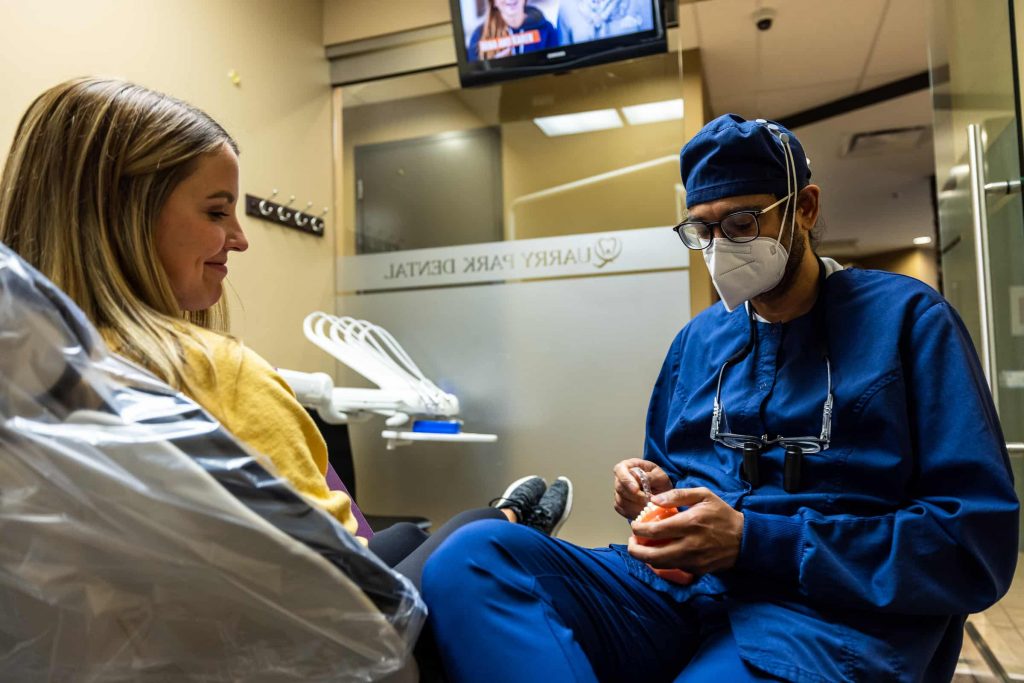What are Dental X-Rays?
Dental radiographs (X-rays) are essential, preventative, diagnostic tools that provide valuable information not visible during a regular dental exam. Dentists and dental hygienists use this information to safely and accurately detect hidden dental abnormalities and complete an accurate treatment plan. Without X-rays, problem areas may go undetected.
Dental X-Rays May Reveal:
- Abscesses or cysts.
- Bone loss.
- Cancerous and non-cancerous tumors.
- Decay between the teeth.
- Developmental abnormalities.
- Poor tooth and root positions.
- Problems inside a tooth or below the gum line.

X-Rays can help you look beyond just the surface of your teeth. Detecting and treating dental problems at an early stage can save you time, money, unnecessary discomfort, and your teeth!
Digital Dental X-Rays
Digital radiography (digital X-ray) is the latest technology used to take dental X-rays. This technique uses an electronic sensor (instead of X-ray film) that captures and stores the digital image on a computer. This image can be instantly viewed and enlarged, helping the dentist and dental hygienist detect problems more easily. Digital X-rays reduce radiation 80-90% compared to the already low exposure of traditional dental X-rays.
Book Your Dental Appointment Today
What are Panoramic X-Rays?
Panoramic X-rays (also known as Panorex® or orthopantomograms) are wraparound photographs of the face and teeth. They offer a view that would otherwise be invisible to the naked eye. X-rays in general, expose hidden structures, such as wisdom teeth, reveal preliminary signs of cavities, and also show fractures and bone loss.
Panoramic X-rays are extraoral and simple to perform. Usually, dental X-rays involve the film being placed inside the mouth, but panoramic film is hidden inside a mechanism that rotates around the outside of your head.
Unlike bitewing X-rays that need to be more often, panoramic X-rays are generally only taken every few years. A panoramic X-ray is not conducted to give a detailed view of each tooth, but rather to provide a better view of your entire mouth. The Panoramic X-Ray Machine helps us look at areas such as the sinus areas, nasal areas and mandibular nerve.
How Are Panoramic X-Rays Taken?
The panoramic X-ray provides the dentist with an ear-to-ear two-dimensional view of both the upper and lower jaw. The most common uses for panoramic X-rays are to reveal the positioning of wisdom teeth and to check whether dental implants will affect the mandibular nerve (the nerve extending toward the lower lip).
The Panorex equipment consists of a rotating arm that holds the X-ray generator, and a moving film attachment that holds the pictures. The head is positioned between these two devices. The X-ray generator moves around the head taking pictures as orthogonally as possible. The positioning of the head and body is what determines how sharp, clear and useful the X-rays will be to the dentist. The pictures are magnified by as much as 30% to ensure that even the minutest detail will be noted.
Panoramic X-rays are an important diagnostic tool and are also valuable for planning future treatment. They are safer than other types of X-rays because less radiation enters the body.
If you have questions or concerns about panoramic X-rays, please contact our practice.
Book Your Dental Appointment Today
Ask Us Anything
We are all exposed to natural radiation in our environment. The amount of radiation exposure from a full mouth series of X-rays is equal to the amount a person receives in a single day from natural sources.
Dental X-rays produce a low level of radiation and are considered safe. Dentists take necessary precautions to limit the patient’s exposure to radiation when taking dental X-rays. These precautions include using lead apron shields to protect the body and using modern, fast film that cuts down the exposure time of each X-ray.
The cost of dental X-rays can vary depending on several factors, including the type of X-ray needed and whether you have dental insurance. At Quarry Park Dental, we believe in transparency and affordability. For detailed pricing, please refer to our chart on the homepage, which outlines the costs associated with our various dental services. We’re dedicated to providing you with quality dental care that fits within your budget.
The need for dental X-rays depends on each patient’s individual dental health needs. Your dentist and dental hygienist will recommend necessary x-rays based on the review of your medical and dental history, dental exam, signs and symptoms, age consideration, and risk for disease.
A full mouth series of dental X-rays is recommended for new patients. A full series is usually good for three to five years. Bite-wing X-rays (X-rays of top and bottom teeth biting together) are taken at recall (check-up) visits and are recommended once or twice a year to detect new dental problems.
Since every insurance plan is different, it’s really hard to say how frequently you can get X-Rays. Most insurance plans do cover X-rays during a certain period, so it’s best that you contact your insurance provider to learn more about your coverage.
If you’re currently pregnant and your dentist mentions that you may need X-Rays, don’t worry! Dental X-rays can be safe and effective even if you’re pregnant because our dental office makes sure to only focus on your teeth and not other parts of your body. While radiation from X-rays is extremely minimal, a leaded apron and thyroid shield will always be placed over the rest of your body to ensure that you receive as little exposure to the rest of your body as possible.
Here at Quarry Park Dental, we believe that it’s critical to visit us while you’re pregnant. Preventative dental, while you’re pregnant, is highly recommended to help you avoid pregnancy gingivitis and other dental complications.

